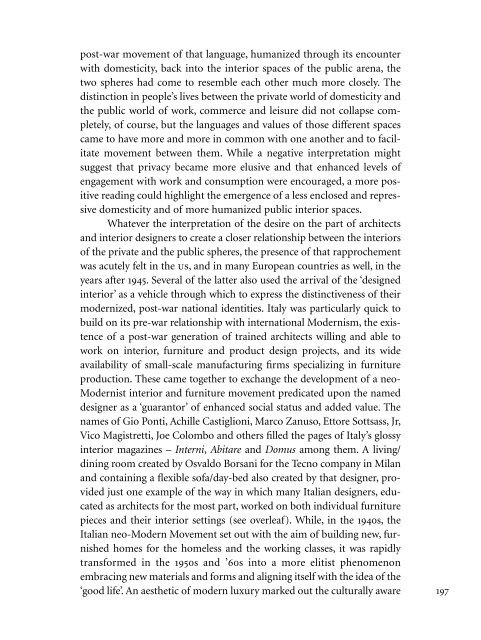You also want an ePaper? Increase the reach of your titles
YUMPU automatically turns print PDFs into web optimized ePapers that Google loves.
post-war movement of that language, humanized through its encounter<br />
with domesticity, back into the interior spaces of the public arena, the<br />
two spheres had come to resemble each other much more closely. <strong>The</strong><br />
distinction in people’s lives between the private world of domesticity and<br />
the public world of work, commerce and leisure did not collapse completely,<br />
of course, but the languages and values of those different spaces<br />
came to have more and more in common with one another and to facilitate<br />
movement between them. While a negative interpretation might<br />
suggest that privacy became more elusive and that enhanced levels of<br />
engagement with work and consumption were encouraged, a more positive<br />
reading could highlight the emergence of a less enclosed and repressive<br />
domesticity and of more humanized public interior spaces.<br />
Whatever the interpretation of the desire on the part of architects<br />
and interior designers to create a closer relationship between the interiors<br />
of the private and the public spheres, the presence of that rapprochement<br />
was acutely felt in the us, and in many European countries as well, in the<br />
years after 1945. Several of the latter also used the arrival of the ‘designed<br />
interior’ as a vehicle through which to express the distinctiveness of their<br />
modernized, post-war national identities. Italy was particularly quick to<br />
build on its pre-war relationship with international <strong>Modern</strong>ism, the existence<br />
of a post-war generation of trained architects willing and able to<br />
work on interior, furniture and product design projects, and its wide<br />
availability of small-scale manufacturing firms specializing in furniture<br />
production. <strong>The</strong>se came together to exchange the development of a neo-<br />
<strong>Modern</strong>ist interior and furniture movement predicated upon the named<br />
designer as a ‘guarantor’ of enhanced social status and added value. <strong>The</strong><br />
names of Gio Ponti, Achille Castiglioni, Marco Zanuso, Ettore Sottsass, Jr,<br />
Vico Magistretti, Joe Colombo and others filled the pages of Italy’s glossy<br />
interior magazines – Interni, Abitare and Domus among them. A living/<br />
dining room created by Osvaldo Borsani for the Tecno company in Milan<br />
and containing a flexible sofa/day-bed also created by that designer, provided<br />
just one example of the way in which many Italian designers, educated<br />
as architects for the most part, worked on both individual furniture<br />
pieces and their interior settings (see overleaf). While, in the 1940s, the<br />
Italian neo-<strong>Modern</strong> Movement set out with the aim of building new, furnished<br />
homes for the homeless and the working classes, it was rapidly<br />
transformed in the 1950s and ’60s into a more elitist phenomenon<br />
embracing new materials and forms and aligning itself with the idea of the<br />
‘good life’. An aesthetic of modern luxury marked out the culturally aware 197



